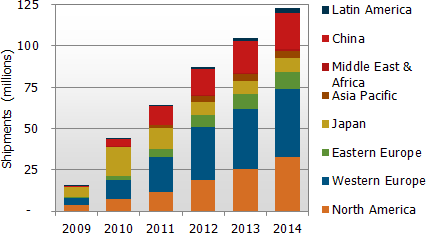 DisplaySearch announced that it reckons almost one quarter of all televisions shipped in 2010 feature some degree of internet connectivity and Connected/Smart TV shipments will top 122 million units in 2014.
DisplaySearch announced that it reckons almost one quarter of all televisions shipped in 2010 feature some degree of internet connectivity and Connected/Smart TV shipments will top 122 million units in 2014.
For more information visit: www.displaysearch.com
Unedited press release follows:
Connected TVs Forecast to Account for 21% of Global TV Shipments in 2010
Emerging Markets Driving Growth
SANTA CLARA, CALIF., December 30, 2010—While the consumer electronics industry prepares its wares for the CES in Las Vegas, the foundations of a quiet revolution in TV viewing continue to be built, with 21% of all TVs shipped in 2010 forecast to have internet connectivity. According to the DisplaySearch Q4’10 Quarterly TV Design and Features Report, the category is forecast to grow to over 122 million in 2014.
Growth of connected TVs was fueled by the Japanese market in 2010 with strong market growth driven by the Eco Points system, and very high penetration of connected TVs, driven by domestic brands’ strategies and by high levels of broadband access. Emerging markets will play a key role in the future growth of this segment, with Eastern Europe forecast to grow from 2.5 million connected TVs shipped in 2010 to over 10 million in 2014. DisplaySearch findings also suggest that 12% of flat panel TVs sold in China in 2010 will have internet capability.
Figure 1: Connected TV Shipment Forecast
Source: DisplaySearch Quarterly TV Design and Features Report
“The looming risk now is what happens if every connected TV gets used,” said Paul Gray, Director of European TV Research. “With Netflix accounting for 20% of peak internet traffic in the US, it’s reasonable to ask if the infrastructure can cope. Set makers need to understand that broadband access does not scale endlessly like broadcast reception.”
It is expected that the connected TV market will diverge, with basic sets carrying enhanced broadcast services such as Hbb.TV and YouView, while the Smart TV segment will enjoy configurable applications, sophisticated search and navigation engines, and advanced user interfaces.
While there is no accepted definition for Smart TV, most have a few key features:
* Capable of upgrades and changes to functionality by the consumer, typically by loading applications
* Able to receive content from the open internet, not just within a “walled garden” defined by a portal
* Possesses an advanced user interface or content discovery engine, to permit rapid discovery and selection of content to watch (but not via a browser and typed search terms as in PCs)
* Able to communicate with other networked devices in the home via open standards (e.g. DLNA)
Smart TVs are not limited to a specific operating system, and Linux (MeeGo) and Android (Google TV) platforms will be joined by others. Google is working with Sony and Logitech for the launch of Google TV, but expect many more entrants in 2011.
“Current shipment levels combined with consumer feedback suggests that Google TV is not yet the Smart TV of people’s dreams,” Gray added. “While adding internet capabilities into the TV is powerful, it needs to be as effortless as channel surfing. However, Google TV has given a good lead into what works.”
The DisplaySearch Quarterly TV Design and Features Report is a quarterly update of the issues and rapid shifts in feature development in TV sets. The 200+ page report examines and forecasts video processor and signal processing IC market development including 120/100 and 200/240 Hz frame rates and market shares for major IC vendors. In addition, the report also features forecasting for MPEG-4 decoding and the digital broadcast environment around the world, including a forecast for DVB-T2; TV connectivity, such as wired and wireless networked TVs; LED backlighting; 3D capability and implementation; remote controls and chassis design; and power consumption.
For more information on this report, please contact Charles Camaroto at 1.888.436.7673 or 1.516.625.2452, or contact@displaysearch.com or contact your regional DisplaySearch office in China, Japan, Korea or Taiwan.
For more information about Connected TV sales and how consumers are using their TVs read more from The NPD Group’s Connected TV User Study
About DisplaySearch
Since 1996, DisplaySearch has been recognized as a leading global market research and consulting firm specializing in the display supply chain, as well as the emerging photovoltaic/solar cell industries. DisplaySearch provides trend information, forecasts and analyses developed by a global team of experienced analysts with extensive industry knowledge and resources. In collaboration with the NPD Group, its parent company, DisplaySearch uniquely offers a true end-to-end view of the display supply chain from materials and components to shipments of electronic devices with displays to sales of major consumer and commercial channels.
About The NPD Group, Inc.
The NPD Group is the leading provider of reliable and comprehensive consumer and retail information for a wide range of industries. Today, more than 1,800 manufacturers, retailers, and service companies rely on NPD to help them drive critical business decisions at the global, national, and local market levels. NPD helps our clients to identify new business opportunities and guide product development, marketing, sales, merchandising, and other functions. Information is available for the following industry sectors: automotive, beauty, commercial technology, consumer technology, entertainment, fashion, food and beverage, foodservice, home, office supplies, software, sports, toys, and wireless.
